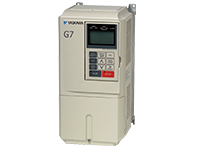G7 Drive
Breadcrumb
Navigation Menu
G7 Drive
G7 Drive
G7 Drive - YAIALL

1/2 - 500 HP
This innovative drive utilizes 3 level control to offer the best solution for challenging installations. Yaskawa is the only manufacturer to offer a low voltage drive with this architecture. 3 level technology minimizes drive induced problems associated with long motor cables and premature motor bearing failures. In addition, overall electrical noise is greatly reduced, resulting in the most problem free installations. Not only does the Yaskawa G7 deliver this exclusive advantage, but it also provides high flexibility and excellent vector performance for control of speed, torque, and position, available in ratings through 500HP.
For more product packages, see G7 Configured.
TemplateWeb
Power
G7 Drive - Options
This array of Power-related options are available for Yaskawa AC drives as shown. Some may be factory-mounted within a drive enclosure, others may be separately mounted.
| Power Options |
More Information
|
|---|---|
| Reactor...Used on either the input or output of a drive to reduce the effect of line-side or load-side transients. These 3-phase reactors are available in a NEMA 1 enclosure for field installation, or factory installed in a Configured package. | |
| DC Bus Reactor...Used in place of an input reactor to improve power factor. Helps attenuate distortion back to the line and to reduce DC bus ripple current. Available only in a factory-installed Configured package. | |
| RFI Filter...Used to attenuate possible drive-generated noise back to the line. Along with proper shielding, routing and grounded between the filter and the drive, it is designed to reduce line-conducted noise levels to within the limits of FCC regulations, part 15 subpart J, for Class A devices. Available only in a factory-installed Configured package. | |
| RFI Noise Suppression Filter...Used to minimize RF noise generation back to the power line. This filter is a delta-wye capacitive filter network. Part# 05P00325-0023 |
N/A
|
| Dynamic Braking 10% Duty...Assists the drive to periodically decelerate a load without overvoltage trips. Dynamic braking consists of at least one transistor and at least one resistor, and is sized for rated motor horsepower. The braking transistor may be included in the standard drive. The resistors are sized for a 10% duty cycle (10 seconds maximum on-time of every 100 seconds), and will provide approximately 150% braking torque. Ten percent dynamic braking is not typically used for "hold-back" type applications such as unwinders, hoists, or downhill conveyors. | |
| Line Regeneration Converters...Yaskawa offers two line-regeneration products, that can provide braking torque in applications that have large overhauling loads or make frequent stops such as elevators, centrifuges, test stands, and winders. Line regeneration can result in significantly reduced operation costs in these types of machinery by "re-cycling" the excess power back to the power grid. The D1000 is a high performance converter with a PWM sinusoidal waveform with very low harmonic distortion (approximately 5% THD) and is designed to meet IEEE-519 requirements. The DC5 is wired in series between the drive and the incoming line and therefore must have an equal or larger current rating than the drive. The D1000 handles both motoring and regenerative power from the drive. The R1000 unit is lower cost with a 6-step output waveform that does not provide IEEE-519 compliant power and can be sized based on the application, from continuous to intermittent. The R1000 is wired in parallel to the drive and only handles regeneration power. The drive handles motoring power through its own diode bridge. |



























